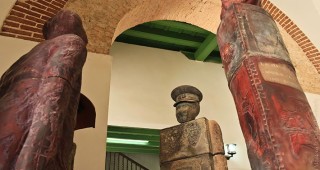Factoría Habana is an experimental center for present-day artistic creation. The institution, which is ascribed to the City Historian’s Office, seeks to become a bridge between Latin American and European art.
Factoría Habana is an experimental center for present-day artistic creation. The institution, which is ascribed to the City Historian’s Office, seeks to become a bridge between Latin American and European art.

 2
2Dominating the Malecón to the west, at the foot of Belascoaín (Avenida Padre Varela), is the massive bronze monument to Antonio Maceo, on top of a marble base in a plaza with a fountain. The classical …

 2
2Inaugurated in 1890, this memorial is a shrine to eight medical students who were executed by firing squad on November 27, 1871, after being falsely accused of desecrating the tomb of Spanish journali …

 2
2This modest aquarium has over 90 different species of freshwater fish and aquatic plants, displayed in small tanks. Tropical fish tanks are popular in many Cuban family homes and fish can be purchased …

 2
2The Institute of Secondary Education of Havana was founded in 1863 and originally located on Calle Obispo. It was later moved to this site in 1924 as part of the construction program for the area in t …
 EclecticAdmission: n-aZulueta e/ San José y Teniente Rey, Habana Vieja
EclecticAdmission: n-aZulueta e/ San José y Teniente Rey, Habana Vieja 
 2
2This 1941 building repeats the structure of lines that emphasize verticality and includes a small two story-tower. Initially known as the Rodríguez Vázquez Building, it included two cinemas, a café-re …
 Art DecoGaliano entre Neptuno y Concordia
Art DecoGaliano entre Neptuno y Concordia 
 2
2Housed within Casa de Francisco Aguilera Basabe, a two-story building built in 1728, this museum exhibits Cuban art pottery from 1950 to the present day on the top floor, while the ground floor has a …
 ColonialAdmission: FreeOpen: 9am-5pm Tues-SunMercaderes esq. a Amargura, Habana Vieja
ColonialAdmission: FreeOpen: 9am-5pm Tues-SunMercaderes esq. a Amargura, Habana Vieja 
 2
2Created by, and housed in the headquarters of, the Asociación Cultural Yoruba de Cuba, this museum is dedicated to santería and features sculptures representing the different Afro-Cuban orishas (saint …

 2
2The Museo Armería 9 de Abril displays a large collection of firearms and bladed weapons spanning the 18th to the 20th centuries. It occupies the former Compañía Armera de Cuba, a private gun shop that …

 2
2First called Cementerio General de La Habana, the Cementerio de Espada was built after the Spanish authorities issued a Royal Edict banning burials in temples because it was considered unhygienic. The …

 2
2The Fuente de Neptuno (Fountain of Neptune) was imported from Italy. Besides its ornamental function, it also supplied water to three boats at the same time, for which large iron rings were placed for …